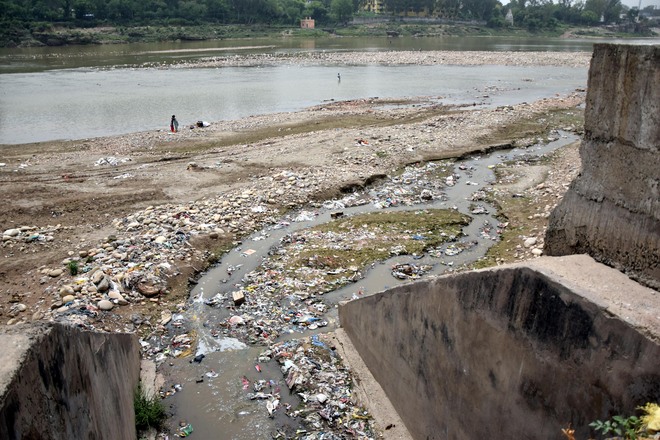Sumit Hakhoo
Tribune News Service
Jammu, April 28
The government’s failure to complete the multi-billion underground sewerage project and dumping of untreated waste into the Tawi, considered as the spiritual lifeline of Jammu, is slowly killing the water body which supplies 60 per cent of drinking water to 15 lakh inhabitants of the temple city.
A walk along the riverbed is all the evidence one needs to know the state of the Tawi, which has its origin in the Himalayas near the Seoj Dhar peak in Bhaderwah tehsil of Doda district.
The biochemical oxygen demand, which reflects the health of a river, is alarmingly increasing in the 35-km stretch from the Sittlee filtration plant to Bagwati Nagar where 12 drains, carrying sewage and solid waste, open in the river.
If the trend continues it could sound the death knell for the river, called the Surya Putri (daughter of sun) by the Dogras.
According to a study by the State Pollution Control Board in 2011, the biochemical oxygen demand at Nagrota, the entry point to Jammu, was 1.2 mg/l. It increased to 3.9 mg/l at the Bikram Chowk. Beyond Bhagwati Nagar the demand went up to shocking 27.2 mg/l.
Even after eight years and spending crores of rupees under the Centrally-sponsored Jawaharlal Nehru National Urban Renewal Mission and the Urban Infrastructure Development Scheme for Small and Medium Towns, several key works to prevent the influx of waste in the river remain incomplete.
The plan was to set up 27 million litre per day (MLD) sewerage treatment plant for Jammu to treat the water before it passed into the Tawi.
Member Secretary, Pollution Control Board, Javaid Iqbal said the pollution level in the river was highest in the city, mainly due to influx of untreated sewerage.
“The condition of river turns alarming when it passes through the city. It could be contained when the sewerage treatment plant will be completed,” Iqbal said, adding that it was in the domain of the Jammu Municipal Corporation and the Urban Environmental Engineering Department.
According to the J&K Water Resources and Management Act, 2010, whoever disposes of household sewage or waste into any water source is liable to be punished with imprisonment for a term that may extend up to one year or with a fine up to Rs 10,000 or both, but it is seldom being implemented.
Before 1947, when the population of Jammu city was 35,000 the quantum of waste water was much less. But with the population explosion, the amount of waste water has increased tremendously. The Tawi is now being used as a sewerage and its water level has very much reduced. A large quantity of effluents from the old city is dumped into the river daily.
“There are six filtration plants — Sitli I, II, III and IV and Boria I and II. If the pollutants increase in the upper stream it will choke the drinking water supply to rapidly expanding city,” said Bushan Parimoo, an environmentalist.
Unlock Exclusive Insights with The Tribune Premium
Take your experience further with Premium access.
Thought-provoking Opinions, Expert Analysis, In-depth Insights and other Member Only Benefits
Already a Member? Sign In Now










